#somewhat historical garment
Text

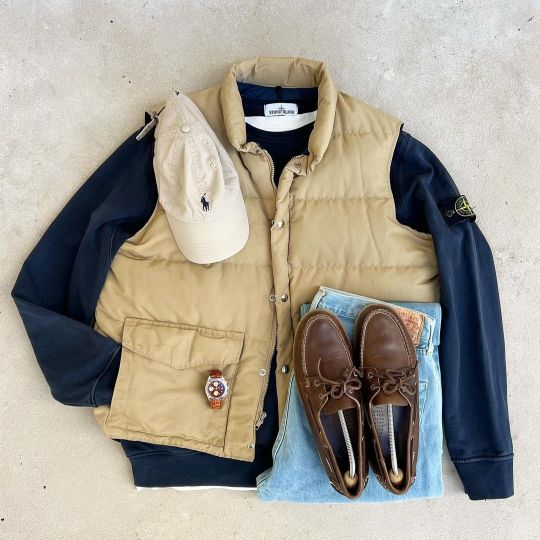
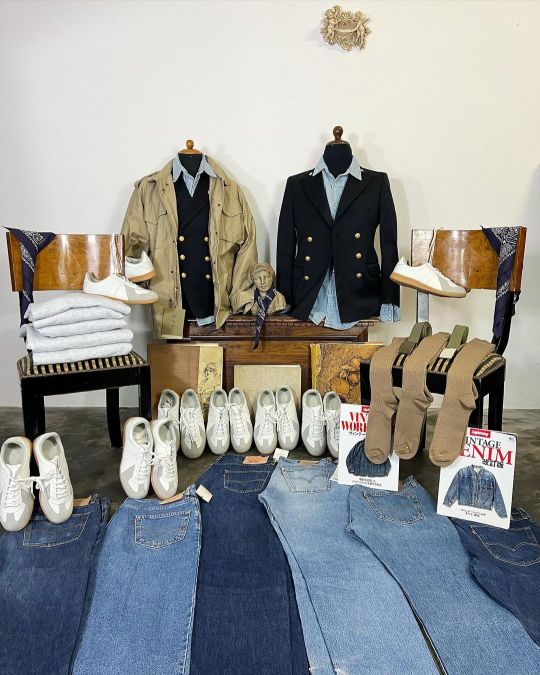
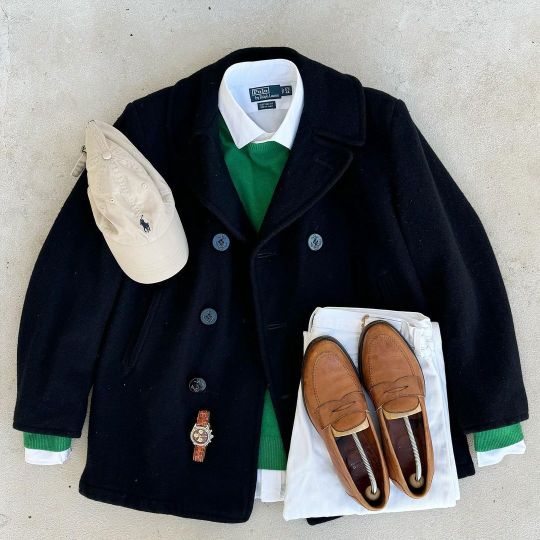
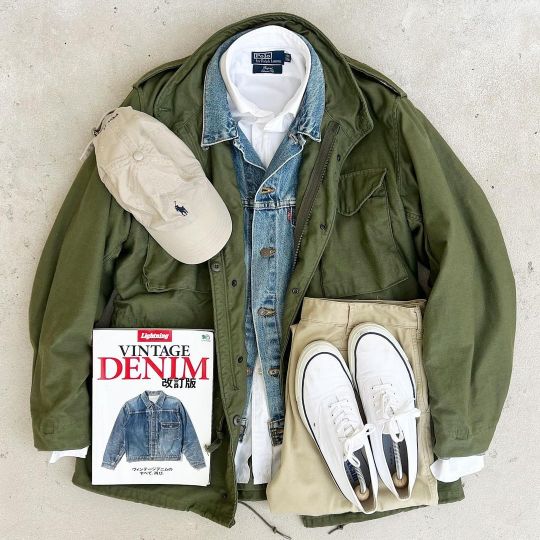
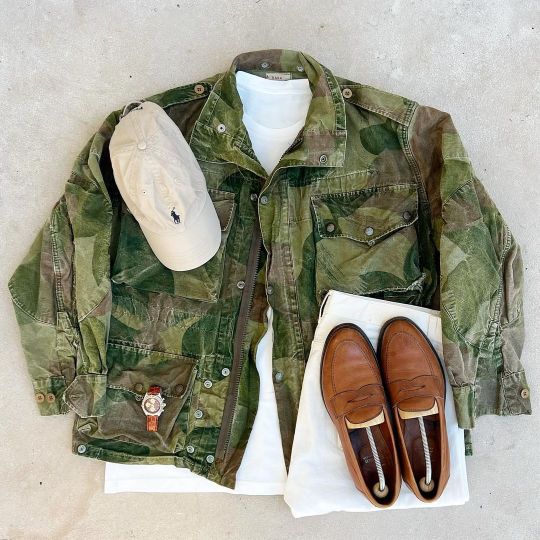
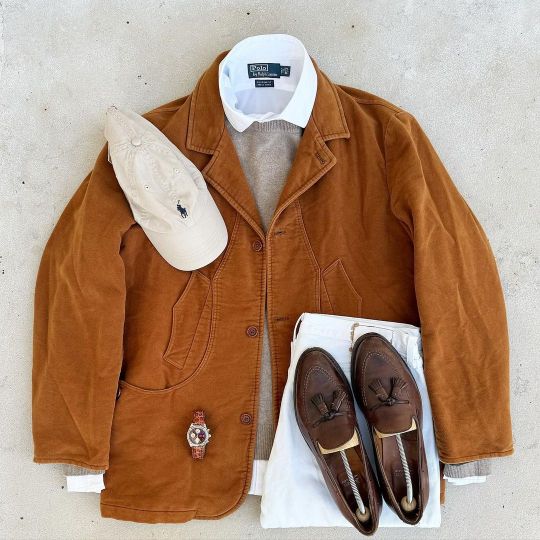

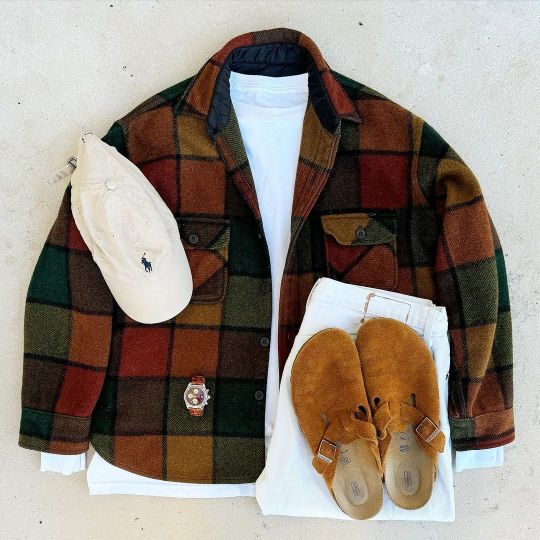

Introducing: Mr. Archive
What better way to kickstart 2024 than with one the most beautifully curated, styled and fair-priced vintage stores out there?
Mr. Archive has been one of my go-to places the last few months, be it for visual inspiration on their instagram profile or the browse some of the most interesting pieces around. To be fair, after 15 years of working in this industry is getting more and more difficult for me to find garments and brands that are truly exciting and fresh. If on top of that we take into account the price point of some of these labels, many of which produce in Portugal with accessible costs, my enthusiasm dims even further.
I’ve always been passionate about the universe of vintage and pre worn garments, but this love has been fueled in recent years by the appearance of highly specialized shops that seem to be perfectly in tune with my personal style. I’ve had the chance to chat with Matteo, the mastermind behind Mr. Archive to learn more about this outstanding project.
BF: I came across Mr. Archive fairly recently and I must say that it definitely hit a soft spot within the range of vintage providers currently on my radar. How long have you been in business? What drove you to create it?
Matteo: I'm passionate about my job, believe I have a somewhat general knowledge of the fashion world, but about 4 years ago, I got fascinated by this industry, even though I already knew it. I come from a family that has always worked in the clothing industry.
BF: For me, your selection is perfectly curated, bringing a mix of military and navy-inspired garments, with a twist of Americana. Is this an extension of your own style and taste, or is it more business-oriented?
Matteo: What I propose is all based on my personal taste; I create outfits on the spot, drawing inspiration from magazines, newspapers, etc., and then I elaborate and create. My mom is an artist, and I think I took inspiration from her.
BF: Vintage has always inspired me ever since I got into fashion roughly 15 years ago. There's just something distinctive about the fabrics and the history behind each garment that you can not replicate with new items. How/where do you source your amazing selection?
Matteo: My pieces come from warehouses worldwide; I'm constantly looking for new things, and that's the wonderful thing about my job! I have strong trust in my suppliers!
BF: With sustainability being the word of order when it comes to fashion, have you noticed an increase in demand for pre-owned garments? Do you think part of the solution can be provided by vintage?
Matteo: Recently, there has been an increase in the purchase of vintage and second-hand clothing items. To be honest, I believe that a few years ago, not many people knew about this world, but now it's expanding and captivating even those who knew little about it.
BF: I noticed you have a small capsule of garments carrying your own label, namely selvedge denim and accessories. What's the story behind those? Can we expect more designs in the future?
Matteo: I won't deny that creating my own clothing line would be a great personal satisfaction, a significant growth. I recently created a small line, "MRARCHIVE," currently composed of jackets, pants, and hats. One day, I'd like to expand, but I still have much to learn and study.
BF: Any tips or advice you wish to leave for those more reluctant to explore the world of previously owned items? It's still somewhat taboo for some people.
For many people, this world is still a taboo; they're still stuck in the thought of "they're used clothes." What I think is that one should see the story and originality behind each piece to appreciate its value, both from a historical and an aesthetic perspective. Sometimes, I compare some clothing items to paintings—they should be framed.
You can find Mr. Archive here.
#Mr. Archive#menswear#men's fashion#vintage#pre-owned#style#fashion#inspiration#beyond fabric#men's style#collection#lookbook#store#shop responsibility#military#navy
211 notes
·
View notes
Text
BARRAYARAN COSTUME DESIGN

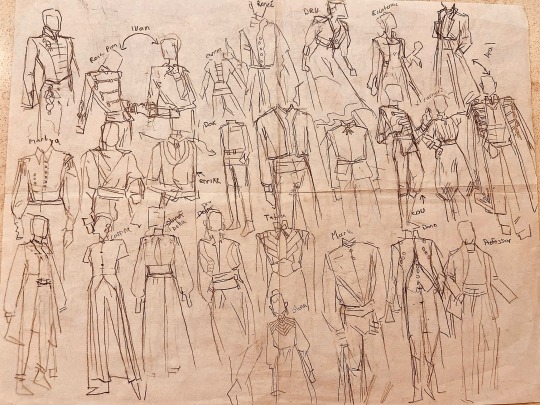
The process for costume design:
Had fun looking through a whole bunch of reference images to try to create a costume set that reflected the strong sense of tradition with midieval-esque holdovers from hand textiles that would have had to be the norm during barreyars period of isolation, while also accounting for the wealth of the current barreyaran aristocracy and their access to modern galactic trends and clothing. I also didn’t want the midieval influences to be generic-fantasy-vaguely-european-bulshit, so I also tried to find reference images with styles, patterns, and silhouettes that where somewhat reminiscent of the French, Russian, and Greek cultural heritage barnyard first settlers may have brought with them. That being said, it wouldn’t make sense for any of these traditional garments to have been preserved with 1-for-1 accuracy from there earth origins over the many centuries (cuz like, irl traditional dress in these countries is less and less common) so I didnt want to just copy exactly historical garments.
OH! And then I also had to make sure the men’s clothing also reflected the pseudo-military affectations which Bujold has mentioned in multiple books as being popular in menswear amongst the vor cast. (Ex: the formal riding boots, and the two swords carried at formal events, or less formally vor “town clowns” also wearing casual clothing reminiscent of a military cut.) but! In order to do this, I had to think of both what would have been military uniforms both in isolation-barrayar and modern barrayar, and which aspects of each set of military uniforms would be incorporated into modern men’s fashion. Would any women’s clothing also reflect this warrior trend?
Finally, since all of this costume design was brainstorming for the dinner party scene, I wanted to make sure that the clothes matched the personalities of the people wearing them. Like aunt Alice and Professors Vorthis are both middle aged Vor-caste women, but will have vastly contrasting style. Alice being alice, her clothing will likely be both perfect for the occasion while also a sleek and elegant combination of the leading barreyaran fashions, while also giving a nod to traditional barreyaran costume at times as she is a representative of both the state and her old-vor house. The professora on the other hand, will probably opt for something comfortable and cozy, while not especially showy, as she is more concerned with her studies and gardens and is not super involved in the Vorbarra-sultana social scene.
Some of the reference images I used:

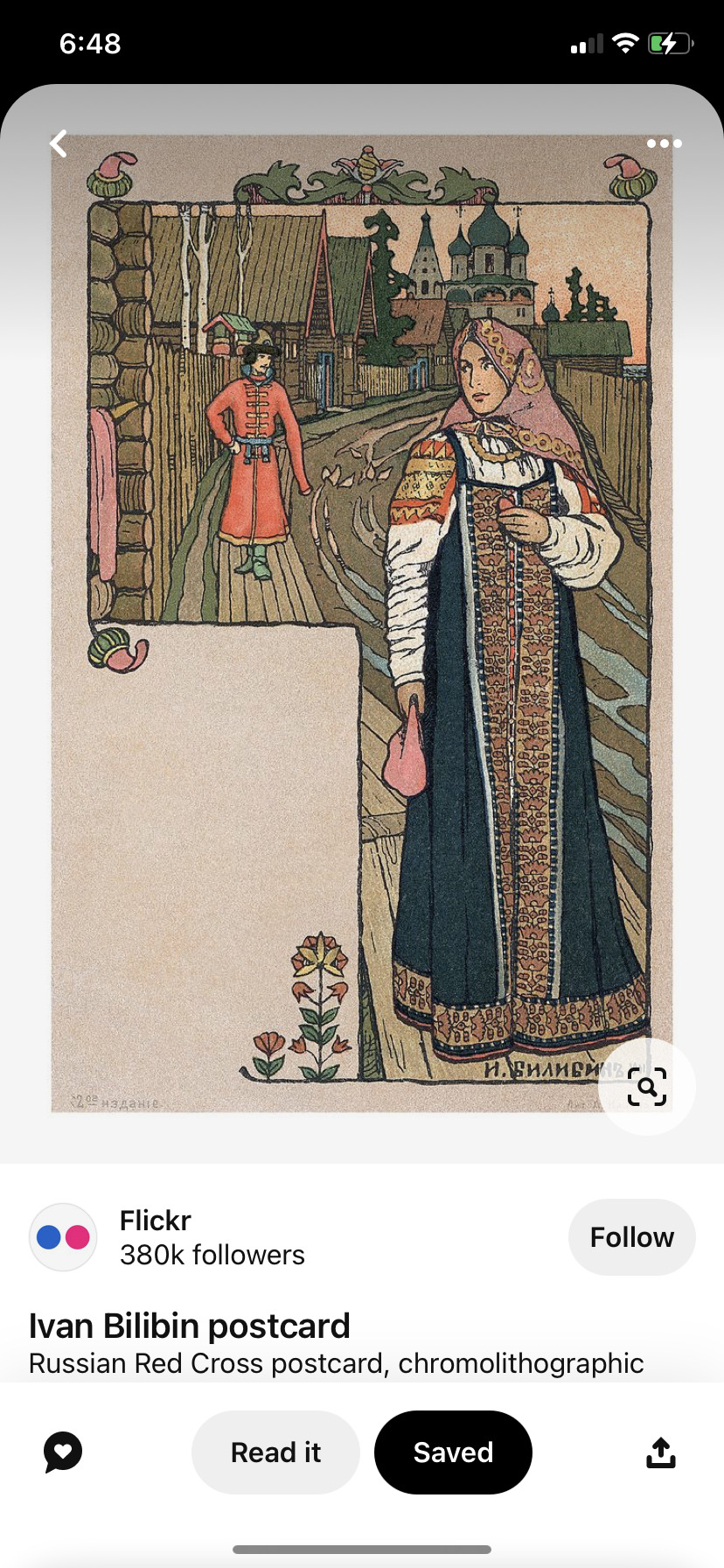





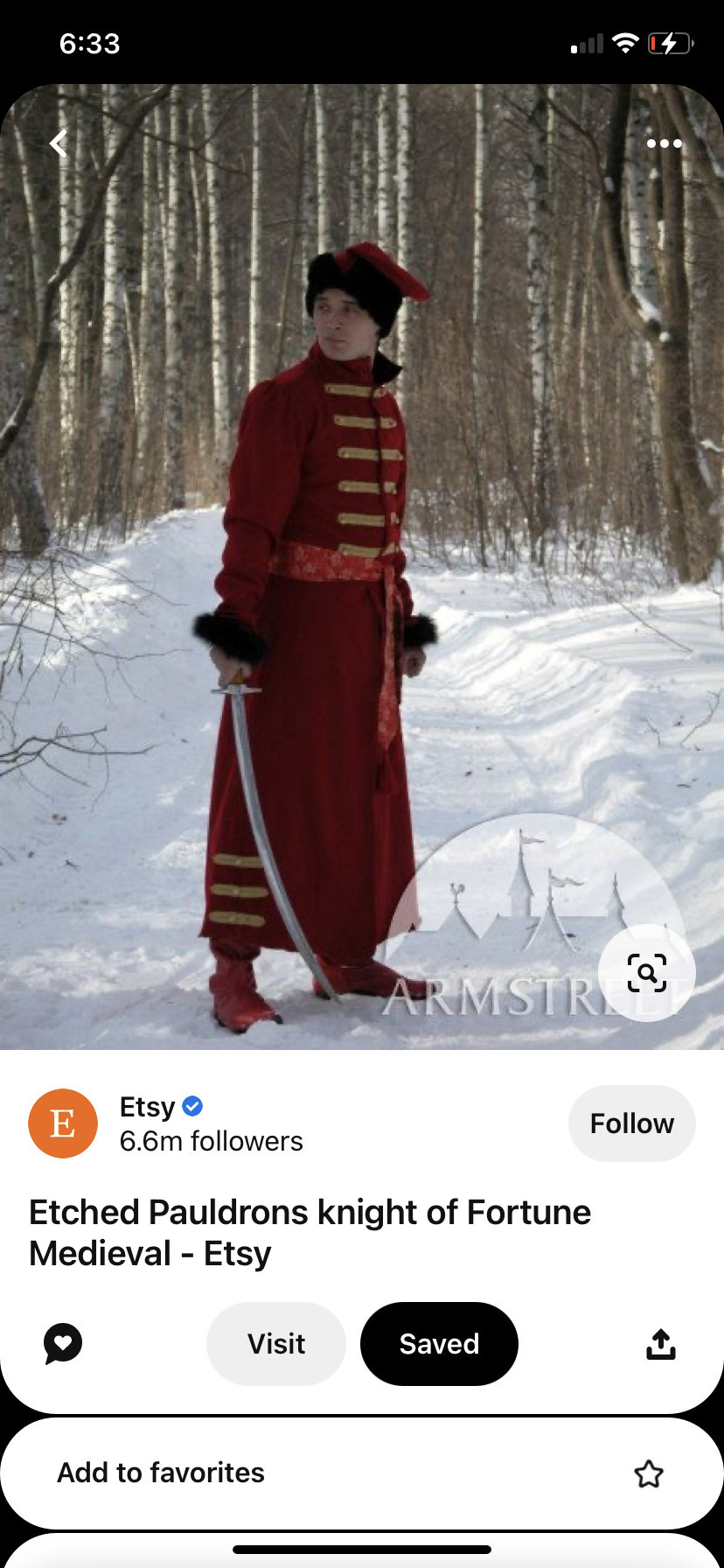
And many many sooooo many more. So much borrowed creativity from all over the internet I feel bad I can’t more accurately site all my sources 😞
Also some random cool aesthetic modern shit that I thought had fun sci fi vibes as well as some *sigh* generic-euro fantasy clothing cuz sometimes you need to be a little basic.
Also a lot of cool art by artists I love that is just dope costume design and totally all their work. Idk the names of a lot of them cuz I’m not really active on social media and only really see the images amidst thousands of others in my Pinterest hoard but I always recognize the artsyles and creativity and wind up saving them to reference art boards 🙈
Some that I do remember and love a lot are cy-lindric, Juliette, and Celia Lowenthall
#barrayar#barrayaran clothing#lois mcmaster bujold#fanart#vorkosigan#vorkosigan fanart#scifiart#costume design#character design#concept art#vorkosigan saga#barrayaran fashion#barreyaran clothes
173 notes
·
View notes
Text
Reenactments and Accuracy
I saw someone in a video talking about why she didn't use silk for an 18th-century ball gown reproduction and the complaints she got about historical accuracy and the expense.
I think EVERYONE misses out on one aspect of this. A ball gown was an upper-class garment that you needed upper-class money to wear.
Jenny who sews the dress couldn't afford the fabric for it. For the purposes of analogy, 'most anyone who does historical reenactments is about at the income level of Jenny who sews the dress. Seamstress was a midlevel skilled trade analogous to today's general office worker. (People who worked for the upper class directly were often considered lucky for the income or relative status and somewhat less abuse.)
14 notes
·
View notes
Text





The Blue and Red Caftan of Jean-Francois Portaels
Or as I like to call it, griping about uncritical (and at times, maliciously misattributed) use of historical images in costume research, especially from Orientalists. I recently came across images 2 and 5 being reposted as Egyptian historical fashion. While the women in these two paintings wear necklaces similar to Egyptian ones, the style of necklace itself was popular across a VERY broad region (I believe I've even seen Balkan necklaces of a similar style). In painting 2 Portaels does not specify where the woman depicted is from, though the title of 5 indicates the depiction intends to be of a woman from Cairo.
In the first image, I can tell you the woman is Moroccan (her earring and under caftan are pretty distinct), though he does not specify this. Woman 2 is wearing what looks to be a yelek, which would indicate she's Egyptian, if we assume she's North African. Woman 5 is probably also wearing a yelek, but the cut looks oddly loose. The difference between the yelek and the caftans more common to the Maghreb is that a yelek is of a tighter cut, and has a low, oval neckline that potentially can reveal cleavage, which is found on a few other contemporary Egyptian garments. In practice, the yelek itself was often hidden under another garment, and usually had an underdress covering the chest, despite depictions otherwise. The exception would be dancers and certain other professions.
Further, the decoration and shape of the garment do not resemble Egyptian garments. A tob sebleh, to my understanding, would have a longer sleeve. The embroidery and cordwork are somewhat unusual and look more Maghrebi, though it's harder for me to judge this definitively as it's hard to find enough detailed photos of Egyptian cordwork to form a general impression. Additionally, I feel like I've seen a Tunisian men's garment that looks almost exactly like this, but in white with gold cord.
Frankly, given this caftan shows up so often, I think it was a real garment Portaels had, and I don't think he cared about where it was from when choosing to paint it. He was an Orientalist painter, and while some of that school painted with great accuracy and humanity, their work always needs to be carefully judged. My guess is that the garment is of Maghrebi origin. It is the sartorial centerpiece of most of these paintings, wfich is why though details of 2 and 5 are accurate enough, I find myself mildly annoyed that these are being shared without context.
#cipher talk#actually egyptian tag#Masr#Egyptian fashion#Egyptian culture#Plus the people sharing these straight up lie and fabricate information sometimes#Like literally pretending Algerian clothing is Egyptian or claiming henna designs based on Nepalese art are Egyptian#Very annoying people
13 notes
·
View notes
Note
I’m wondering if you have any examples of Irish clothing from the early 1600s (around 1610-1615)? I haven’t been able to find much from this era so I’d appreciate any sources or museum collections that you could recommend.
Starting this out with the caveat that if you're looking for the same level of detail and precision that we have for English dress history in this period, you are going to be disappointed. The types of English primary sources we have for this period (well-dated detailed paintings, well-preserved rich-people clothing, wills, printed books, etc) just don't exist for Ireland. There also seems to be much less research interest in 16th-17th c. Irish dress history, so there isn't nearly as much for secondary sources (books, articles etc.).
You don't mention if you are interested in a specific region in Ireland. Ireland in the early 17th c. was a pretty heterogeneous place. People in Dublin and Waterford wore English-influenced styles. According to British-appointed solicitor-general Sir John Davies, by 1606 a few of the wealthier people in Connacht had started wearing English dress, but many others were still wearing Irish clothing. Ulster was a mix of Irish who were wearing Irish dress and incoming English and lowland Scots settlers.
All of the extant Irish clothing I know of from the early 17th c. comes from either bogs or archaeological excavations. It looks like you've already seen my post on extant garments at the NMI. The NMI also has a couple of felt hats that might be early 17th c. This one is from Knockfola, Co. Donegal. It originally had a decorative cord or band where the pale line is:

There are also another cóta mór and brat, found on a bog body from Leigh, Co. Tipperary, which I don't think the NMI has on display. I did not bother to include them in my post, because they are so similar to the ones from Killery, Co. Sligo, but the fact that these have been found in multiple places suggests that they were common, widely-used garments.
The other major garment-find from this period is the Dungiven outfit which is in the Ulster Museum. a short video The bright blue thread was added by a modern conservator; it's not original. (Side note: The identification of this outfit has gotten unfortunately politicized. Tartan trews were worn by both the Irish and the Scots during the 17th century (McClintock 1943, Dunlevy 1989). The presence of tartan should not be used to draw conclusions about the ethnicity of the wearer.) The primary publication for this outfit:
Henshall, Audrey, Seaby, Wilfred A., Lucas, A. T., Smith, A. G., and Connor, A. (1961). The Dungiven Costume. Ulster Journal of Archaeology, 24/25, 119-142. https://www.jstor.org/stable/20627382
The one other reasonably-well preserved outfit that has published on is from a child burial from Emlagh, Co. Kerry, now at University College Cork. Shee and O'Kelly give it a late 17th c date, but they largely base this date on the presence of a rather generic-looking comb. IMO the outfit could easily be early 17th c.

The Emlagh gown, photographed on a living 8-year-old child who was wearing a sweater and skirt underneath. (The 1960s was a different time.)
The bodice has a wrap-front closure with a back and button-up sleeves similar in cut to the Killery cóta mór. The skirt is a pleated rectangle with the pleats sewn in vertically, somewhat like the Shinrone gown. Publication:
Shee, E. and O'Kelly, M. (1966). A Clothed Burial from Emlagh, near Dingle. Journal of the Cork Historical and Archaeological Society, 71(213), 81-91.
There are also, frustratingly, a bunch of fragmentary clothing finds at the NMI which might be 17th c, but no one seems to care enough to do publications on them, and NMI Archaeology still does not have their collection on-line, so they are useless to us.
The typical Irish shoe for this period is known as a brogue (also called a Lucas type 5 by archaeologists). broguesandshoes.com has photos, a pattern, and construction information.
Unfortunately, the illustrations from Speed's map are the only images I know of from this specific period.
If you want details on what materials were used, I recommend Susan Flavin's dissertation. It's about the 16th c. economy, but things didn't change that much between 1599 and 1601. free download here
If you don't mind wading through early modern English and a bit of period-typical prejudice, I recommend reading A Discourse of Ireland, by Luke Gernon written in 1620. His description of Irish clothing starts halfway down p. 356.
Finally, if you can find them, Dress in Ireland by Mairead Dunlevy (1st ed. 1989) and Old Irish and Highland Dress by H. F. McClintock (1st ed. 1943, 2nd ed. 1950) are the best books I know of for this period.
15 notes
·
View notes
Text
Continuation of this
Pietro clutches at her skirts, but reels back obediently when she smacks his desperate hands.
“Please, my sweet,” he begs, trailing after her, resisting the urge to grab her again. “Please talk to me. Tell me what you’re thinking.”
Kelsi doesn’t deign to look at him, simply storms through the estate — a historic castle that had been rather beautiful before her death — hunting down any scrap of her old life.
Her satchel and carpetbag are still in the downstairs closet, exactly where she left them. Even the contents is untouched, a few crumpled receipts and an expired granola bar buried inside.
She grabs both, and the big, red rain coat. Pietro always used to hide candies in the pockets; she stops herself for checking for one.
When she emerges from the closet, he’s directly behind her, so close she can see the tears budding in his eyes, not yet fallen. She doesn’t soothe him—she won’t.
The kitchen is dilapidated. She can’t find anything edible, only food so spoiled it can hardly be considered food at all, and a staggering amount of coffee grounds. Maybe he’d been surviving on caffeine alone, these past years.
“Please,” he tries again. “Kelsi, please?”
“You know my thoughts, Doctor.” She pushes past him, up the stairs to the second floor. The boards creak miserably under her weight, untreated, in poor condition. “I am very, very, very upset with you.”
Despite the derelict condition of the rest of the castle, her room could almost be considered clean. There’s a fine layer of dust on most of the surfaces, but it’s clear that the bedding has been washed somewhat recently, the curtains beaten to get rid of the worst of the residue buildup.
Her wardrobes contents is different, although not how she would expect. New clothes, garments shes never seen before, are hung amidst the rest. They’re soft to the touch, don’t show the signs of deterioration and rigidity that come with neglect.
Pietro had regularly washed each each of them by hand, ironing them carefully before returning them to their rightful place. He wasn’t sure why. During the first few months, he thought she should be comfortable, when she returns. Soon enough he hardly thought at all. It was more of a ritual, a lower-brain habit, to tend to her things, to hunt for any remnants of her scent among the items, to imagine her, vital and alive in these spaces.
She understands this, somehow, without a word. Another exhibit of the madness that consumed him in her absence. Grimacing, she starts shoving fistfuls of fabric into her bag, indiscriminately.
At the bottom, tucked away in the corner, is a pair of boots. Pretty, but functional, fine, embroidered details and treated leather.
The night before she died, she’d complained about her feet aching. They’d surveyed the entire surrounding woods, an arduous endeavor that left her exhausted, sore. He’d gifted her a warm balm, of his own recipe. Awkward as he placed it into her hands; he’d wanted to rub it into her tender muscles himself, she could see the desire in him. But it was a line neither of them had ever broached, a delicate, tremulous thing.
He’d pulled her out of deadly mires. She’d plucked poison barbs from his skin. They’d both risked their lives and reputations for each other, again and again. They knew one another better than anyone. At times it seemed like they could read each other down to the flickering soul.
And yet, there was another distance impossible to broach. Not due to lack of courage, but careful sensibility. It required investigation, a steady hand. Whatever it was between them, it often felt as fragile as spiders silk.
Now it was snapped, forever.
Kelsi shoves into the boots, swallowing down her distaste. It was this, or go barefoot on her journey. She snaps her bags closed. She’s ready to be gone.
Pietro stands in doorway, preventing this.
His head is bowed, fearful of her gaze, but even hunched his height is imposing. She always thought of his as a sproutish man, lean and lanky, but facing him now she’s not sure she could beat him, physically.
“Can you please—“ he bites his lip. “Can’t you be very, very, very upset with me here? Where you’re safe? Where I can see you?”
Kelsi just breathes for a moment. She’s so incensed her rage has surpassed physical revile; she’s only focused on undoing what’s been done, now. “No,” she tells him.
She takes a step forward. And another. They’re toe to toe, and she can almost feel his heart beating, a rabbit-quick pulse. His cheeks flush.
He presses himself into the doorframe, letting her pass. Yielding.
He falls in stride behind her. “Dearest, please. Things are not as you remember them.”
“I know,” she snaps. “You did that.”
His fingers brush her sleeve, cautious but beseeching. “Where are you going?”
“To get them out. I will extract them. Somehow.”
It takes a moment for her to realize Pietro is no longer right behind her. He’s paused in the center of the lobby, staring at her. His expression is hard to decipher, agony and confusion and something without a name.
“You can’t,” he says. She can barely hear it.
“I’m certain I’ll find a way. If there’s any trace of them left in me, I will pluck it out.”
“You can’t,” he says again, louder. “You’ll die.”
She shakes her head. “I already did.”
The great door was never her first choice for access. It’s twice her size, and so heavy she has to throw her entire weight against the wood to budge it. Pietro is saying something to her, but she can’t make it out, too focused on escaping his madness to try.
Finally, the door rocks open.
On the other side is a giant, bloodwasp.
The creatures, roughly the size of a toddler and infinitely more dangerous, had all but vanished from the estate and its surroundings after Pietro’s carnivorous plants took root. Kelsi hadn’t seen one for years after she moved in.
She’s certainly not prepared to deal with one, now.
In her shock she doesn’t hear the click of the bullet in the chamber, but the sound of it firing her knocks her to the ground.
The wasp falls too, dead, a perfect shot through the eye.
Pietro rushes to the door, shutting it quickly. Beyond him, Kelsi spots the thrumming bodies of at least three more wasps. Who knows what their numbers are, how many lurk outside.
Pietro sinks to his knees at her side, bundling her up with an arm around her shoulders, a look of ardent concern on his face. In his other hand, the revolver is still steaming.
“I meant to tell you that the roads are no longer safe,” he says, “but you wouldn’t listen. Now, let’s talk about this like civilized adults.”
But he makes no move to release her. Simply holds her there, against his chest, reveling in skin that’s warm again.
Weakly, Kelsi asks, “Dr. Pragma, where did a scholar learn to shoot like that?”
#a study in devotion#adoring mad scientist x darling he brought back to life who wants nothing to do with him#spoiler but um….#tw insects#tw wasps#pathetic wet dog of a man pretty handy with a gun actually#he is actually very strong under the tweed#Kelsi will ALWAYS win their fights though because he could never even think of harming her#I love them they’re SO fucked up and insane
28 notes
·
View notes
Note
Hi! I have a question about... sleeves.
I am looking at designing what is essentially, in-universe, a stage costume but still want it to be at least a tiny bit historically accurate.
It would be a late Jiaqing era (~1810s) inspired aoqun, with a mamianqun (specifically a fengweiqun) and possssssibly a cloud collar to form an ensemble that's intended to portray a fenghuang (thus the skirt lol) and probably somewhat fancy on account of the celestial nature.
I know that sleeves in China have historically often been either long or Extremely Long especially for noblewomen but I was wondering about how that extends (ha) to the Jiaqing era of the Qing Dynasty.
I see, for example, Ming-style clothing that has these very long, drapey sleeves such as these: https://ziseviolet.tumblr.com/post/702949049252364289/ (though I know the Ming would have ended like 200 years before the 1810s but I also know you've mentioned that a lot of Ming fashion continued into the Qing for a while) I like the way they look on account of being very flowy which seems fitting for a bird-themed outfit where the person wearing it would be essentially portraying the fenghuang onstage, so long flowing gauzy shapes seem very fitting, but I'm not sure how much flexibility there is for late Qing sleeve styles or how much creative license goes into those types of XYZ dynasty-inspired outfits.
Relatedly I'm curious how common sheer, soft-draped fabric like that would have been in the early 1800s. I know it was very popular in certain eras, and of course in western fashion at the time Regency clothing used a lot of soft loose shapes, so I'd be interested to know if that kind of thing was particularly common in the 1810s in China or not.
I think sleeves started getting much shorter and more tight fitting in the 18th century, but wide sleeves saw something of a revival by the turn of the 19th. In the Jiaqing era, sleeves could be described as wide but not necessarily long, and usually had folded cuffs that reduced the length. I haven't read about actual garments from that period so I can't tell you concretely, but that appears to be the case from artworks.
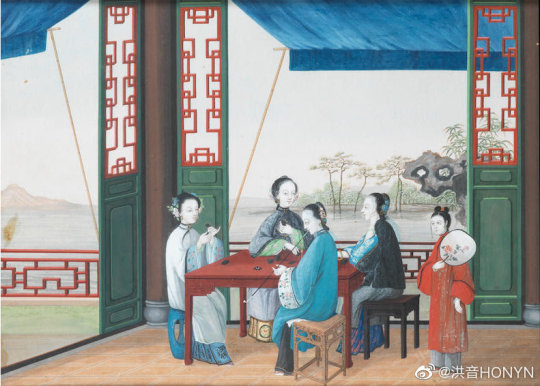
The blogger 盥薇 did a recreation of Jiaqing era dress based on export paintings, in her interpretation the sleeves are also still a little too long to be entirely practical but definitely not as long and drape-y as that in earlier centuries. This outfit might work as a reference for your costume, since it also features a cloud collar? (on a side note, the comment section of this video gives me psychic damage, please don't look)
About sheer, soft fabrics, yes they were indeed very popular around this time, and had been since the late Ming. Sheer clothes were usually meant for lounging around the house in warm weather and not worn outside, and sometimes you see women represented as forgoing underwear altogether. I'm not sure whether that's an artistic embellishment, but it does feel feasible given the domestic setting.
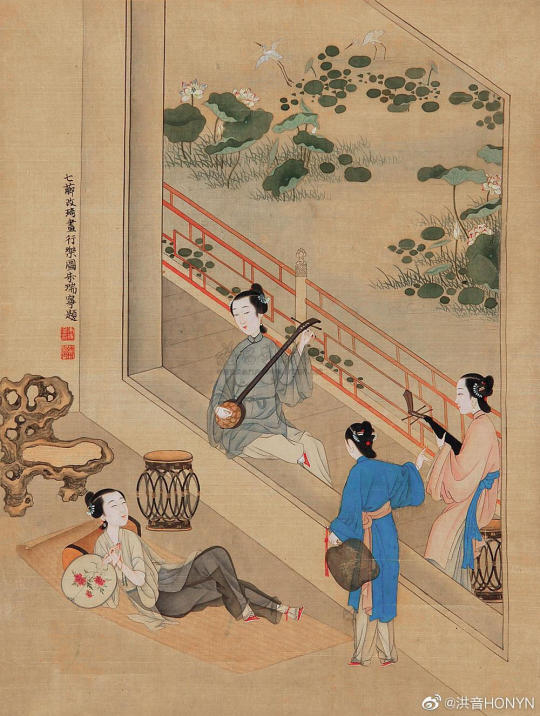

I explained in this post that the cliche of 'late Ming fashion continuing into the Qing' only actually applies to the 1650s. So the Jiaqing era, being in the early 19th century, has nothing to do with the Ming.
63 notes
·
View notes
Text
Story Ideas (TW: long post incoming but there's poll at the end and every participant gets a sticker)
As was decided by about 100 people: here are some ideas I had for IFs (all in different degrees of "worked-out" and at the end, you can vote on which ones you find the most interesting.
1
The first one basically makes the MC a teacher at a prestigious high school (although they might make you do classes at the also very prestigious elementary school) and it involves planning lessons and dealing with usual teenage shenanigans. The ROs would be other teachers, the odd parent maybe, and perhaps someone from maintenance? Who knows... It's meant to be a cute slice-of-life thing because I eat that shit up.
2
For this one, I pretty much only wrote down "It was a beautiful day at court and you are a horrible jester". ROs would be Prince/Princess, maybe a foreign visitor with Oberyn Martell vibe.
3
The MC is part of a big mafia family but is mostly trying to live a somewhat normal life. Now, you are acquainted with the family business but you don't play an active part in it. But if someone was to mess with you, well, your family would do anything for you. This one is inspired by the song "Bust Your Kneecaps" by Pomplamoose.
Now to my three favorites:
4
Are you familiar with the novel "Krabat"? We've read it in school and I thought it was really cool, even though it is a little dark, to be honest. It's based on a cluster of Sorbian legends and follows the story of Krabat, a poor orphan boy becoming an apprentice at a mill, where the miller is also practicing and teaching black magic to his twelve apprentices and every year one boy dies in mysterious circumstances. The title I'd give this would probably be "Rapaki", which is Sorbian for ravens, which play a role in the story as well. It could prove to be a challenge to make this historical setting as inclusive as I want it to be (and also since there's a specific character I'd love to have as a RO, but he's an adult and the apprentices are pretty much all teenagers).
5
You were kidnapped by aliens. Now, it's been a couple of months since you arrived at the space station. They don't really seem to want to do anything with you except study humans and you happen to be one of the subjects. You are given spacious living quarters, activities for enrichment, food (they sometimes test things by giving you weird stuff and see if you eat it or not) and even many opportunities for socialization with the other human subjects. Honestly, it's not bad. Beats scrambling for money to pay rent. The newest addition to the human sample group though seems to be very discontent with their new abode. Are you helping them to escape, are you just tagging along for the ride, or are determined to stay in your cozy lab?
6
You are perfect nobility. Your family is hosting a ball to which all the most important members of the ton are invited. There's good food and drink, entertainment and music. You socialize and dance. You even go for a secret midnight swim in the deep fountain in the gardens. Many days are like this and you enjoy it. But one day something very peculiar happens: The ball is in full swing when you notice a person in very strange clothes just striding through the dance hall, never acknowledging the guest or the music but looking at a strange... device in their hands. When they aim to go upstairs towards your private living spaces you decide to follow them but they simply disappear. Were they a ghost? Are you hallucinating? For several days you see more strange figures, some of them in strange clothing, some of them in garments from the past. They never seem as ... corporal as the first one and at this point you fear you have lost your mind. Then the first intruder comes back and you can confront them. They seem awfully aghast when you politely ask them to leave.
Turns out, you are a ghost, reliving the last day of your life, and they are a ghost hunter from the future. The whole manor as you know it seems to crumble, polished floors become broken wood, the furniture disappears and the big chandelier lies demolished on the ground. You learn that the other figures are ghosts, like yourself, former inhabitants of the manor before and after you. And you meet them. They are as flabbergasted by this revelation as you were. The ghost hunter explains that they've been chasing a haunting spirit for some time now and they actually weren't intending to call forward you or the others. Do you all help them catch the evil ghost?
Inspired a little by the bbc chow "Ghosts".
#story ideas#another thing I thought of that would be better as a novel or movie probably is something about Fredericka “Marm” Mandelbaum#You should definitely read the wikipedia article about her#that's girlpower if you ask me
36 notes
·
View notes
Text
i realize i approach dressmaking a little strangely to the people near me (not you, tumblr, you're a bunch of fiber arts and art in general freaks, you vastly outdo me) because i suppose they see it as something of an utilitarian hobby (as in, its end is for me to have pretty clothes that look good on me so that i may. i don't know. get a husband or possibly just present as a somewhat put together adult human.) but to me the endgame is just... having a well made garment. it is the having made, with my own hands, a piece of clothing that is done well, finished well, structured well, etc. me looking good in the clothes and the clothes being accomplished are two entirely separate things in my mind, and the second has far more weight in my regard. which i'm not entirely sure is appropriate, and certainly at large a historically disdained perspective (which i only mention by virtue of being who i am), but it does make me feel a little kinship with the designers that make impossible garments nobody can wear just so they exist out of their imagination
#i do think you cannot divorce clothing from its function#half the battle is getting it to LOOK good on the human body#if i was making clothes for somebody else obviously that would take precedence#but as it is my own clothes then half the battle's already lost#and i've always been more a maker than a shower#psa newsmen still at large
2 notes
·
View notes
Text
Dior, Alaïa, & Saint Laurent
I was fortunate enough to visit several haute couture house museums while in Paris! We explored La Galerie Dior on our second day in Paris along with the Fondation Azzedine Alaïa (which was also hosting an exhibit of Madam Grès' works) later that afternoon. Then, on the second to last day of our trip, we went on a guided tour of Fondation Pierre Bergé-Yves Saint Laurent.
Dior:
The first that we visited was the Dior Museum, which was dazzlingly maximalist. Definitely my style— I always prefer a more ornate, extravagant aesthetic as opposed to a minimalist one. Right from the get-go, the entry staircase was flanked by a massive glass wall displaying a rainbow of miniature Dior items. The museum was set up so that visitors would be taken through a chronological timeline of Christian Dior’s life and legacy. His designs transitioned from relatively classical and simple to over-the-top and lavish to somewhat of a combination in more recent times. The exhibits were divided into significantly different individual sections. The second section was especially maximalist, featuring some of Dior’s boldest works in front of artwork and underneath an abundance of hanging flowers. My photos don't quite capture it, but this part of the museum reminded me of the highly constructed, decorated, and dimly lit environments of aquariums— in a good way.
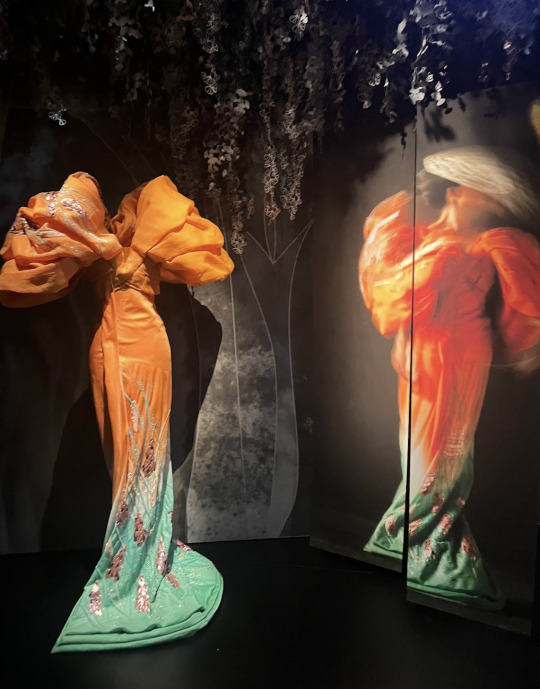



In high contrast, a following section of the museum was bright and featured white and red garments. This segment reminded me of a modern art museum or maybe even a laboratory, crisp and sterile.
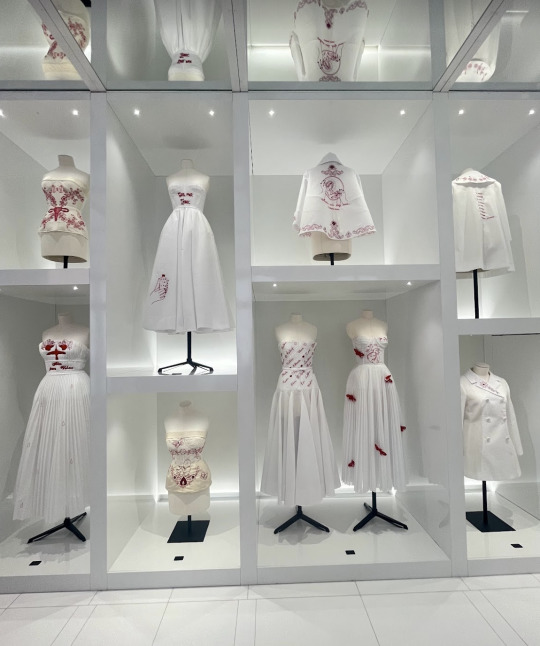
Dior's appreciation for historical period fashion was evident in many of his works. Here are a couple of my favorite designs of his inspired by the clothing of the past:

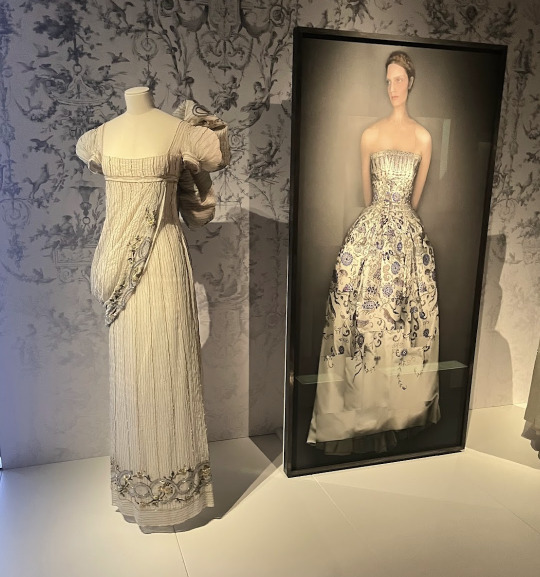
The language conveyed in Christian Dior's designs is definitely one of classic luxury. Dior’s fashion language prioritizes beauty over comfort and practicality. His work is ostentatious in a way that is commonly associated with old-world wealth— highly intricate and embellished, bold in colors, shapes, and/or texture, strictly feminine silhouettes— eye candy, basically, but often forgoing wearability and accessibility.
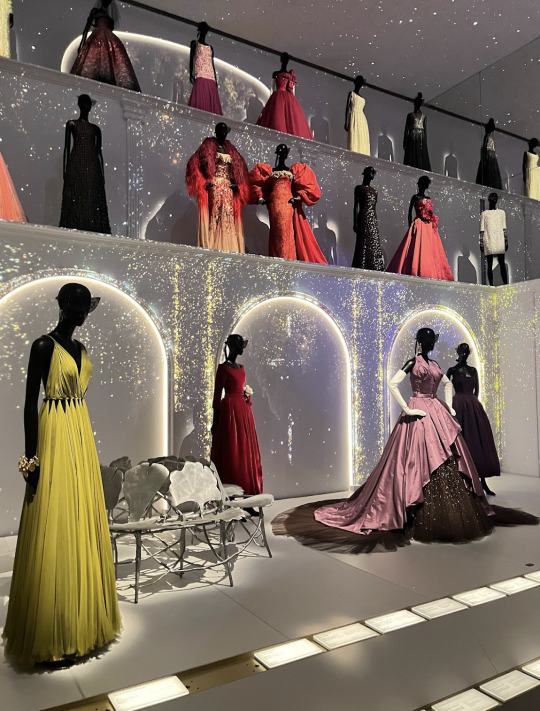
Alaïa:
After exploring the Dior Museum, we were taken on a guided tour of the Azzedine Alaïa Foundation. Unfortunately, I was too exhausted and sore to appreciate this exhibit as much as I would have liked to and because of that, I don't remember it as well as the Dior and Saint Laurent Museums. However, I do recall the stark difference between this museum and the Dior Museum. Alaïa's designs as well as the style of the exhibit itself were significantly more modern and minimalist. This is not my cup of tea, but I do think that they complemented each other well. My favorite part of this tour was examining the similarities and differences between Alaïa and Madame Grès' designs. The people who constructed the exhibit placed similar works from the two designers side-by-side so that they could be more easily compared and contrasted, which I appreciated. Alaïa and Grès had similar draping techniques and a shared love for monochromatic garments. Since there was no apparent experimentation or boldness with color, the designs instead were unique in their shapes and textures. Alaïa had an affinity for using sheer fabrics in his designs, whereas Grès was much more modest (as would be expected of that period).
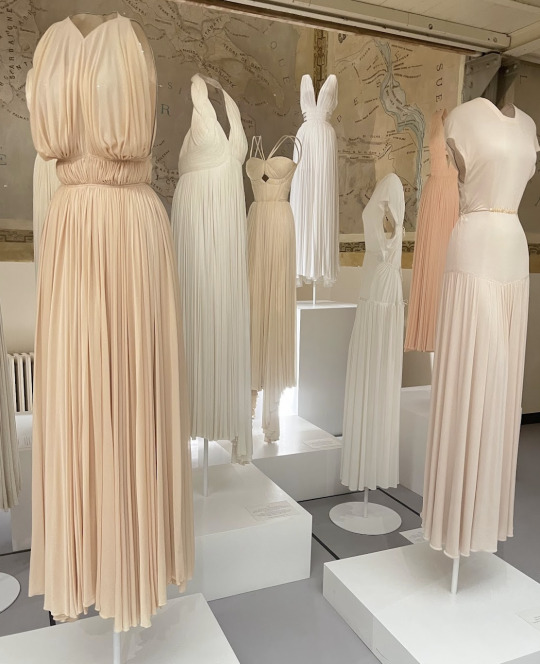
Alaïa’s designs imbue a language of modern elegance and liberation. His use of draping and sheer fabrics and general lack of intricate details draws the eye to the shapes and movement of his garments and, consequently, the people wearing them. Grès’ designs convey more classic elegance and simplicity while being somewhat more modest than Alaïa’s. Although I don’t typically have a preference for more modest clothing, I will say that while examining their works side by side, I gravitated towards Grès’ garments. It’s a bit difficult to explain, but they looked like they were designed by a woman. They were constructed in a way that seemed especially considerate and knowledgeable about women’s bodies. I could picture myself in her dresses, but I couldn’t see myself wearing almost any of Alaïa’s designs. They looked uncomfortable in a way that’s tough to convey. It wasn’t necessarily the fabric or the shapes, I think that, at least partly, it was the cuts and sheer fabric placed in inconveniently revealing areas. Many of his dresses looked like the type that I would be fiddling with and checking on constantly if I were wearing them, always anticipating a wardrobe malfunction. Based on what I’ve learned about him, I do think that the intended fashion language in his designs was to be liberating for women, but it just didn’t quite resonate with me.
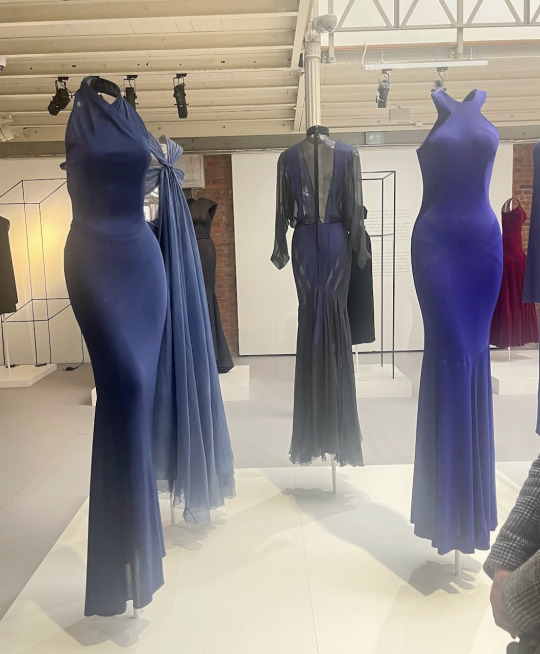
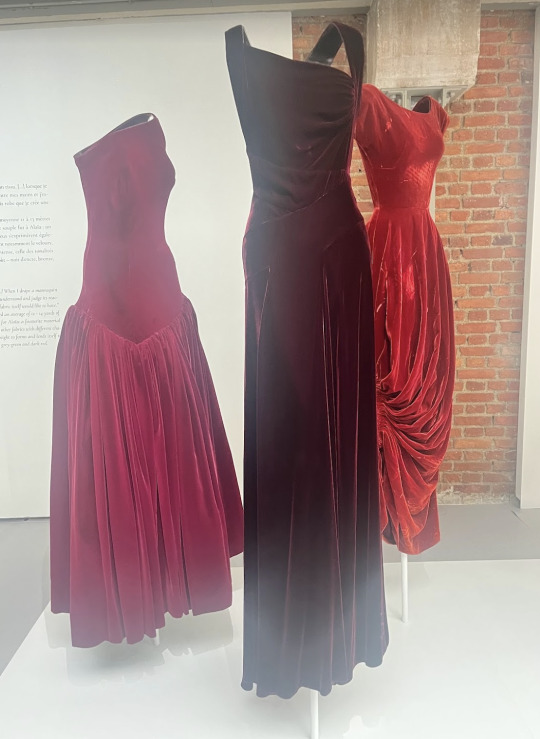
Saint Laurent:
For a multitude of reasons, the Yves Saint Laurent Museum was my favorite out of the three! Yves Saint Laurent revolutionized women’s fashion. He invented the women’s smoking tuxedo, popularized ready-to-wear collections, merged artwork and fashion, championed racial diversity in the modeling world, and so much more. Watching the YSL movie in class on top of the familiarity I already had with the designer and the brand made me all the more excited to see this museum! Part of this exhibit highlighted Saint Laurent’s use of sheer fabrics in his work such as chiffon, lace, and tulle with the intent of liberating women’s bodies. In contrast to some of Alaïa's pieces with smaller sections of sheer fabric, Saint Laurent's pieces were often entirely sheer or with large cutouts. This distinction made Saint Laurent's use of transparent fabric feel more assertive than Alaïa's.

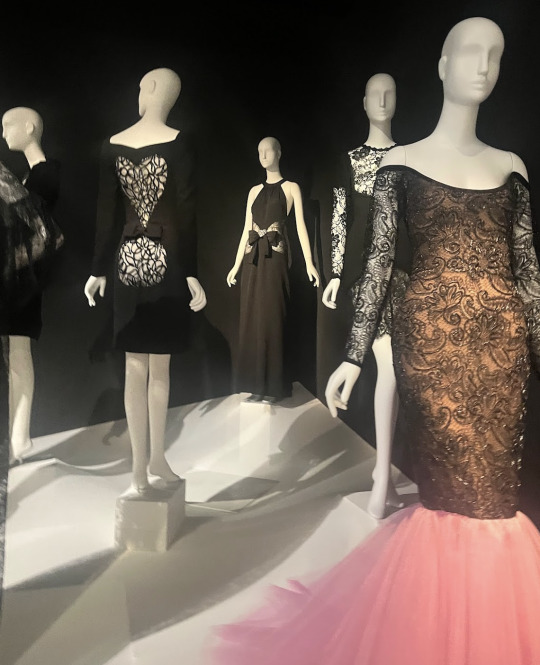
Saint Laurent also layered sheer fabrics to create an illusory appearance to his designs, giving them a depth and softness that I really admired.

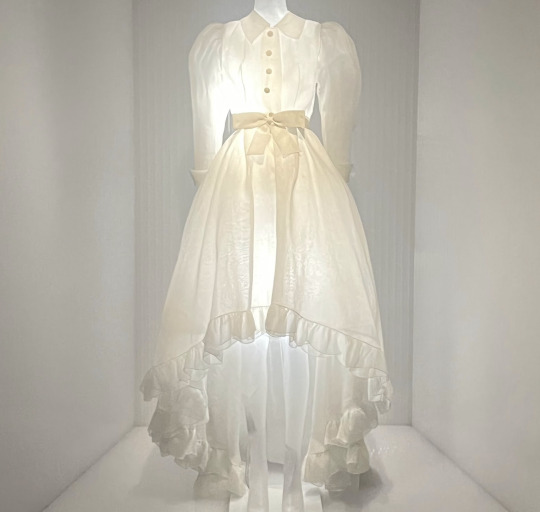

Much of his work also had a looseness to it, present in many of the photos above, that contributed to the language of liberation Saint Laurent conveyed through his clothing designs. They look comfortable and freeing, like the woman is wearing the clothes, not the clothes wearing the woman.



The comfort and freedom that Saint Laurent exudes through his designs is something I didn't find particularly present in either Dior's or Alaïa's work. Their clothes may be for women, but Saint Laurent's work is truly for women.
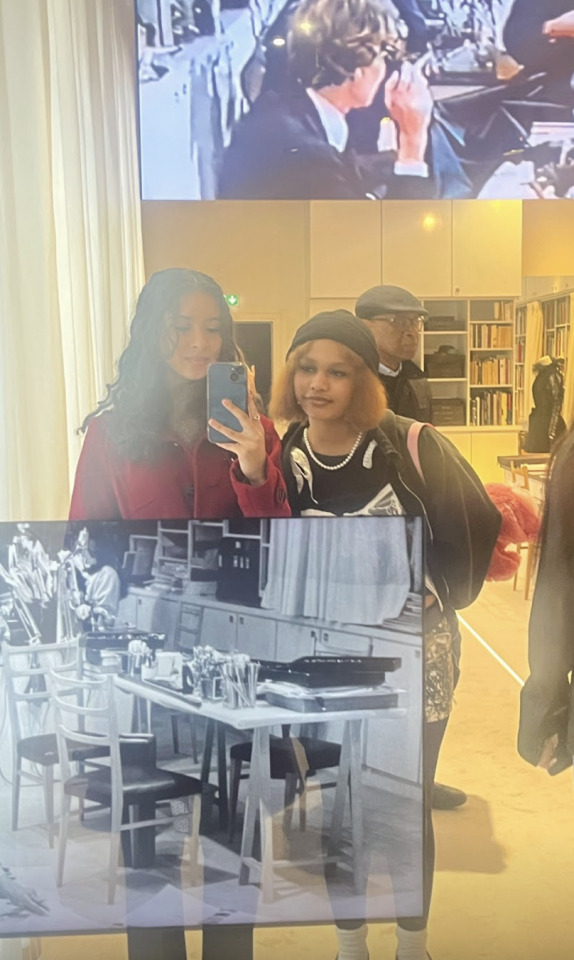
Sources:
My own memory, my own photos.
2 notes
·
View notes
Note
I found your blog via a the historical clothing tag and I love your 1840s pants and the waistcoats and shirts you posted! As a somewhat butch/androgynous person who really likes historical fashion but is worried it's too binary for me to make it work, I'm curious how you find inspiration and ideas of what you historical clothing will fit your vibe, and how have you adjusted patterns to work for you?
Hi there-- thanks for stopping by! I am no expert but I will give you my thoughts.
I pretty much only wear men's clothing, and the same goes for historical fashion-- the trousers I made and some other garments are from Black Snail Patterns, which I found to have accurate patterns that were pretty easy to follow.
In terms of historical fashion being binary: it's definitely true that most available patterns out there are for either men's or women's clothing, because fashion in a lot of eras has been pretty sharply divided by gender. However, those gender norms can differ pretty wildly from our own, and some clothes that might have been seen as conventionally masculine in the past (silk stockings, ruffled shirt-fronts) can read as more androgynous in the present.
Also-- you do not have to abide by historical binaries! You can wear stays with knee breeches, or a tie-on pocket with a waistcoat! If you are just looking for clothes you enjoy, and not for reenactment events or something where strict accuracy matters, the most important thing is finding something that works for you fashion-wise and gender-wise.
The trick is definitely finding masculine patterns that will fit non-cis-male bodies. Learning a little about pattern drafting can help-- that way you can take your measurements and adjust patterns to fit you, and even make your own patterns if you can't find any that work for you. Some older garments are actually more forgiving than modern ones; I followed Marius Lee's video to make my 18th-century shirt, and it was mostly big rectangles, which did not require a lot of adjusting for body type. Even though I hate making mockups, I recommend making yourself do it, so you can see if you need to fix the pattern before you chop up your good fabric.
@vinceaddams has some incredible resources on 18th-century menswear, and @rowzien has some more 19th-century examples that are amazing-- I would recommend checking out their blogs!
Hope this helps!
25 notes
·
View notes
Text


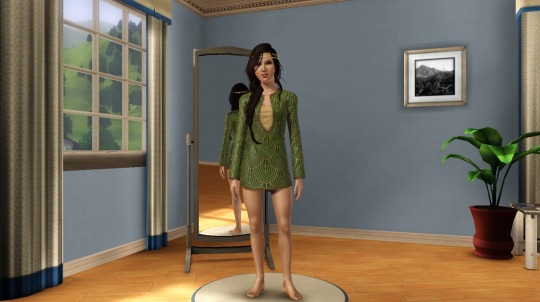
Here's another CAS post of the festival costumes that didn't make the main story. These are worn by the Alto family, and this post features the last teen 'elite' costume.
I learned the Alto's names during my wiki search to acquire the first names of the Vidals who I shared last week. On Joel's page I discovered his relationship to Ashley (third shot) and when I clicked through I was able to identify her and her parents, Alfonso (first shot), and Lopita (second shot), as sims I'd dressed for the festival.
Since Alfonso and Ashley's outfits aren't just color variations of costumes previously shared, I will talk about Lopita's garments first. Last week while discussing Valerie Vidal's costume, I mentioned the women's skirt lengths and there relation to position. I noted that Valerie's short skirt was a rank demotion and that before the demotion, her household held the same position as the Alto's. Valerie's original outfit would have been identical to Lopita's (pictured above) and their outfits are pretty much identical to Carolina Ichtaca's save for the headpiece and different colors.
As stated last week, the Vidals and the Altos were the right and left hand of the Ichtaca during the region's colonization. While the women's identical outfits denote the same rank, the men's outfits, which differ slightly, reflect different roles. The Altos were the left hand of island conquest. While the Vidals played peacekeepers and brokered trade and treaties, the Altos stabbed enemies in the back and stole territories. To represent this, I selected a longer hooded (although the hood isn't up) top and colored the face of Alfonso's mask dark green as oppose to gold to suggest a role in the shadows. These are the two detail differences between Alfonso's costume and the current right hand costume which I've yet to share.
Now it's time to get into some of my frustrations.
Styling the Vidals and Altos made me realize just how little attention I've paid (and apparently EA paid) to teens. My options in CAS were quite limited, and even though I'm very cc friendly I still had a hard time finding teen island themed pieces outside of modern swimwear. I wanted Ashley's outfit to fit the location and also be somewhat modest as the 'elites' are meant to be a little stuffy. What she has on was the best I could do, and I can't say I'm happy with how things turned out. I've got nothing deeper to say about her fit than this was all I had. If there had been more than one 'elite' teen girl in another family holding a different position from the Alto's I don't know what I would have done clothing wise. The limitations of my choices made me both happy I didn't take shots of any 'elites' for the actual story, and even more frustrated that I don't know how to make or convert cc. I would absolutely love for all of the fantasy and historical costumes that @venusprincess-ts3 makes to be available for teens, and while I realize I can make some NRAAS adjustments so teens can wear adult clothes, I hate getting excited by possibilities only to end up with neck gaps and/or dresser changing outfits on top of possible game crashing.
#TS3#FarmTown#TropicalVacation#TS3gameSetup#ts3gameplay#ts3 gameplay#TheSims3#TheSims#@venusprincess-ts3#venusprincess-ts3#Simprofiles
9 notes
·
View notes
Text
Witcher Fandom: Costume Historian Weighing In On Episode 1
my first post that’s screenshots next to art/garments they remind me of and a little commentary
Renfri

Important details to highlight:
-Wrap around top with a separate piece as the collar
-Fairly tight sleeves

Portrait of a Young Man; ca. 1508 Hans Süss von Kulmbach, German
NGL I had completely dismissed finding anything for Renfri because of how anachronistic her design seemed to me re: historical design (because of her pants and leather armor) but I was wildly delighted to find this piece. I was drawn to the similar wrap-around structure with a separate collar piece to add stability. In the painting it seems more like a jacket with sleeves that button open along the arm, but I’m still chuffed!
;) hair’s not so different either
Stregobor

Important details to highlight:
-High gathering on the sleeve head- though not a puffed sleeve
-Small ruffle on the cuffs and collar of his shirt/smock
-Unstructured overgown/surcoat (considered somewhat unfashionable/worn by old men by the 1550s)
Originally, I’d placed the silhouette much more in 1500 because of the length of the skirt on his jerkin and his wearing an overgown/surcoat but high neckline, the absence of a true puffed sleeve, and the long line of buttons pushes this forward in time
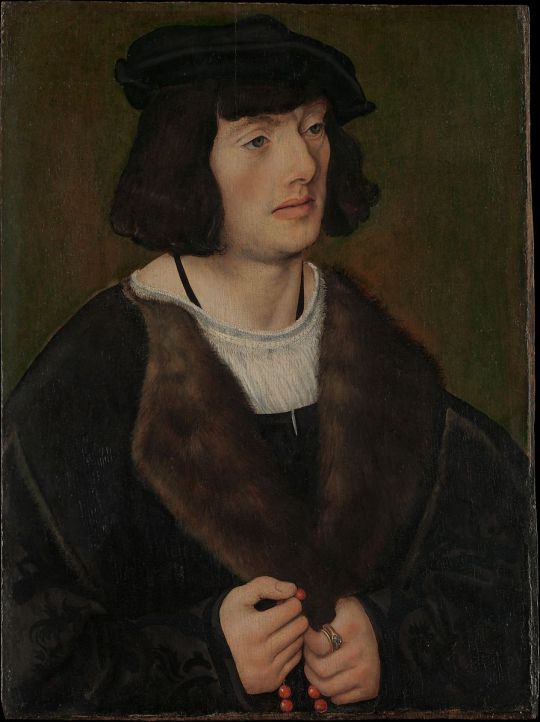
Portrait of a Man with a Rosary ca. 1508 Lucas Cranach the Elder, German
The neckline here is low compared to Stregobor but you can clearly see the kind of overgown/surcoat that Stregobor wears: they were often trimmed with fur, as in this painting, but they were typically fitted through the shoulders and loose around the body.
On the arms of the doublet, you can also see what appears to be a damask or brocade fabric- though much much subtle than Stregobor’s!
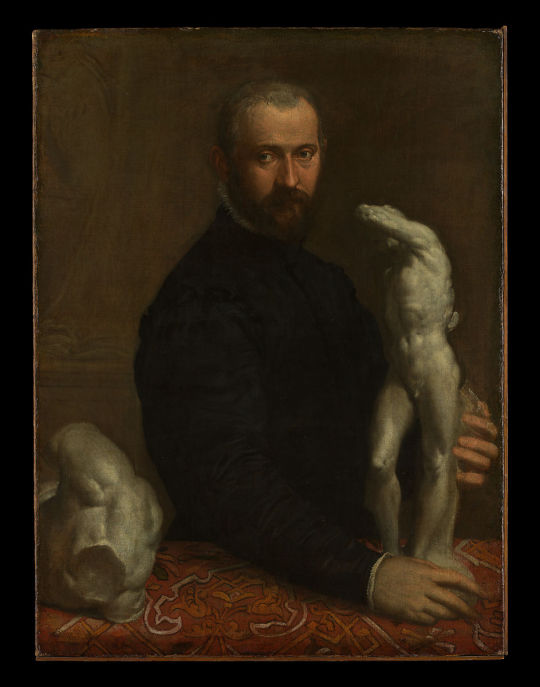
Alessandro Vittoria ca. 1580 Paolo Veronese (Paolo Caliari), Italian
Here we can see a sleeve much more like Stregobor’s- it’s gathered high in the head and tapers down into a slimmer fit on the forearm. We can also see the ruffles of his shirt at the cuff and collar. There’s a line down the front, and I can’t see if there’s buttons because of the image quality, but fabric or thread covered buttons to “blend in” with the garment were also made at the time!
Danek

Important details to highlight:
-Breastplate with vertical striped ornamentation
-Relatively low/smooth line to the pauldrons
-Relatively small/tight spaulders
-A low pigeon breast curve to the breastplate
-Low collared gorget
Hello I know very little about dating armor
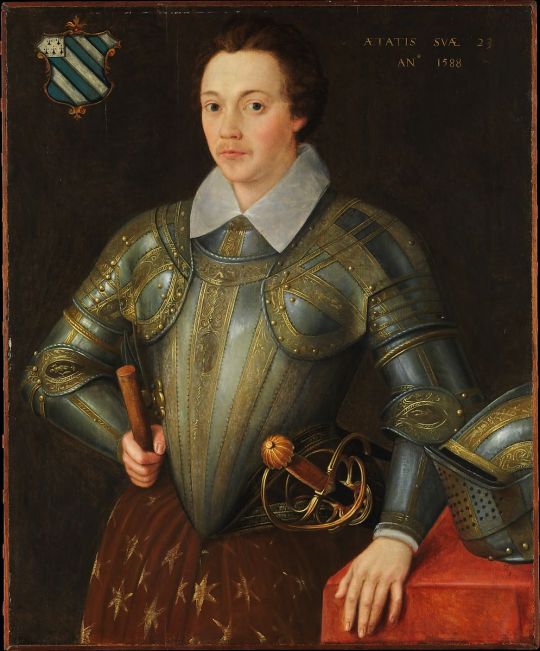
Sir John Shurley of Isfield (1588) British Painter British
Arms and armor are hard for me to date but I feel like these look like contemporaries
Calanthe (helmet)

Important details to highlight:
-High Ridge
-Visored
-Angled Cheekguards
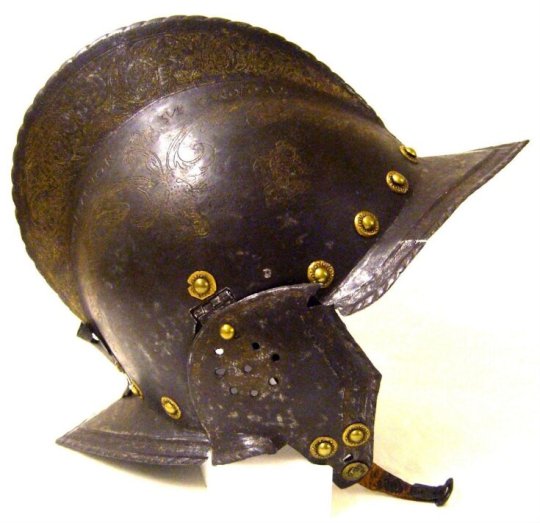
Burgonet ca. 1585 Italy
If I remember correctly, this is the style of helmets worn by pikemen and cavalrymen- the ridge was to redirect the force of a direct bashing blow
Marilka

Important details to highlight:
-Straight cut to skirt
-Low neckline on her smock/chemise
-Waist is high under the bust
We don’t have many dated and easy to discern peasant outfits in the historical record- but what I really like about Marilka’s outfit is that the palette is in a natural and available dye color. Her skirt is in the range of what you can dye with madder and her coat/bodice is a mostly blue / sort of green which you can achieve by overdying woad with weld.

Juni, Brevarium Grimani, fol. 7v (Flemish) circa 1510
As I said above, here’s a good example of the color palette in the historical record. For the closer woman, the blue portion you can see is probably the bottom half of a kirtle which would also have a laced bodice. Marilka could be wearing a kirtle under her jacket: many didn’t have a “front” portion as we would know them- some of them had a full back and just tied across the front to accommodate different sizes. The jacket has short sleeves which would have provided additional protection from the sun and like Marilka they have a v front.
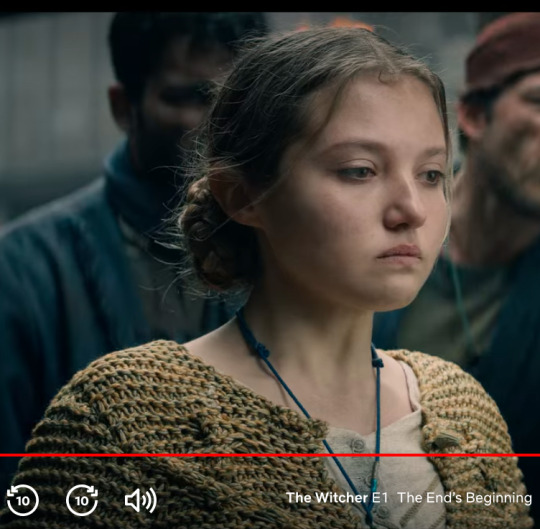
okay hello everyone I am not going to go down the rabbit hole of the history of knitting here too like I’m sorry it’s weird and complicated and hard to explain but TL;DR knit garments of the time were not like Marilka’s they were like this because of complicated political/guild reasons and also the price of labor and wool
The Knuckle Bones Crew
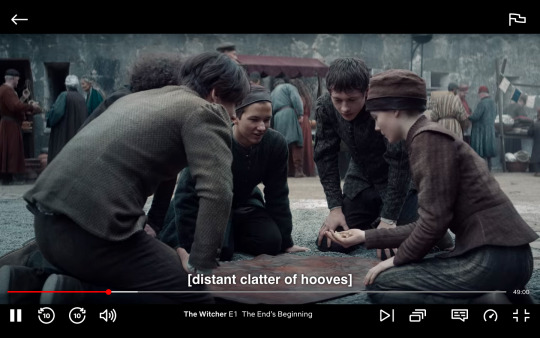
Important Details
-High shoulders to the jackets
-Lack of puffed sleeves, some with shoulder “wings”
-Trunks/Hose are close to the legs
The puffed sleeves generally drop from fashion in the 1560s and the puffed trunks/breeches drop in the 1570s where they become baggy and become more fitted in the 1580s. Though in the 1580s, the doublets generally had longer skirts so I’d generally place this in the 1590s.

Doublet 1605-1610 (made), 1870-1895 (altered) England
This is from a decade later- so the waist line on the jacket has risen a bit. Here you can see the double seams of the sleeves (along the front and back of the arm) that allow for a tighter fit and full range of movement. You can see the shoulder wings here- rather conservative. In the 1590s the wings were wider in length, and in the 1600-1610s they were thicker. Interestingly, along the waist seam you can see small holes/eyelets where the hose/breeches/trunks would lace into the doublet! That lacing held your “pants” up
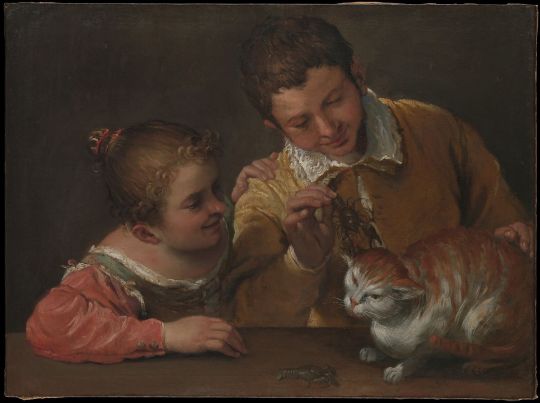
Two Children Teasing a Cat (c. 1600) Annibale Carracci Italian
NGL I just thought this was cute
Ciri

Important Details:
-High Narrow Shoulders
-Sleeves Coordinating (not matching) Body
-Slight puff to shoulders
Separates for women were a thing that we know was common though there’s fewer portraits I can find of it. Women wearing doublets was a trend in the Elizabethan era (c. 1560-1600). I think her full outfit has a separate matching skirt and there’s a peplum on the doublet which did happen.

Portrait of a Lady in Black and White - Alessandro Allori (Florence) c. 1590
This is a rather fanciful example but here we go: a front closing women’s doublet/gown with coordinating sleeves. Under the ruff, there was likely a grown-on collar as Ciri wears. I’m peeved because I know I’ve seen examples much closer to what Ciri wears but I can’t find any right now.
.
I skipped over a few screenshots I originally wanted to do (Eist, the ball guests, and Mousesack/Ermion for sure) because I’d already spent two nights on it but if there’s something you’d like me to unpack- I’d be happy to do it for you <3
#Witcher Fandom: Costume Historian Weighing In#the witcher#stregobor#marilka#ciri#Cirilla of Cintra#cirilla fiona elen riannon#danek#calanthe#queen calanthe#renfri#renfri vellga#the end's beginning#the witcher season 1 episode 1
48 notes
·
View notes
Note
You like historical clothing, yes? Would you be willing to either give me some tips or resources about historical Lithuanian clothing for men?
Thank you!!
Sure I who not mind, i choose the ancient baltic clothing
Early Iron Age (I–IV centuries AD)
Clothing is believed to be of a tunic style. Tablet-woven sashes with simple, longitudinal designs are worn, tied at the waist or to embellish the garment edges. The cloth is woolen, woven on vertical frame looms in a 3-shaft twill pattern. Women’s headwear is embellished with small, round or flat metal pieces, their fronts adorned with ornaments hung on twisted, two-stranded wire. Another special type of women’s headwear from this period covers the temples with a symmetrical pair of flat, ring or coil shaped ornaments. We still do not know if this jewelry was worn for specific occasions. The metal ornaments from the period are subtle in form, made of silver filigree, with incrustations of azure blue glass and framed in red, black or green enamel.
In the later part of this period, these types of ornaments, as well as elaborate multicolored glass bead necklaces brought from the Roman Empire, are no longer in evidence. The dominant technique for making ornaments becomes metal casting; decorative elements echo patterns found in tablet-woven sashes: longitudinal designs made up of dots, triangles, or series of open circles. Designs on brooches consist primarily of arched ladders. Long needle-like pins worn by women are bobbin shaped, or less commonly they have rounded blue ends, worn in pairs, joined together with one or two small chains and pinned to the shoulder region. Ornaments worn around the neck have trumpet or cone-shaped ends, often with azure blue dangles. Bracelets are massive and cut from a round piece of metal, or less commonly, made from braided pieces of metal. During this period both men and women wear such arm decorations, usually one on each wrist. Bracelets made of braided metal are especially popular.
Middle Iron Age (V–VIII centuries AD)
The clothing style as well as the cloth worn during the Middle Iron Age remains much the same as before: the woolen cloth is still woven on upright frame looms, and sashes have the same linear patterns. The metal ornaments, however, are not as subtle in style as before. They are much larger and the bodies of many of the pins and brooches are made of bronze and covered with a thin layer of silver; minimizing the amount of precious metal used.
During this period women begin wearing skull caps – a few rows of short woven decorative elements, interspersed with cast flat metal pieces, decorated with metal eyelets and strung together on woolen thread. Bracelets are still massive, with only the portion encircling the wrist being somewhat narrowed, their ends are now wider. Women wear one or two on each arm, while men adopt the habit of wearing one very large bracelent on the left wrist. This is the so-called “warrior” bracelet, intended to protect the wrist when holding a battle shield.
Necklaces made of glass beads are typically worn only by women, although men of the Aukštaičiai tribe also wear such neck ornaments. Both men and women wear amulets made of amber – typically a large bead, cone-shaped at both ends, that was hung from a brooch, sash, or woman’s straight pin. As before, needle-type pins are worn in pairs, connected with small chains and decorated with small hanging ornaments. In the northern regions these are a woman’s primary accessory clothing element; brooches, such as those worn by men, are not found with their clothes.
The women of the southern Baltic tribes use brooches to fasten their clothing. These are circular in shape, cast in bronze or silver, and often decorated with serpent head motifs, or sometimes with poppy seed pods. Men wear leather belts with raised metal clasps, and sashes from which they hang their weapons, and tall boots fastened at the knee with belt buckles.
Late Iron Age (IX–XIII centuries AD)
During the Late Iron Age the ornamentation of the clothing worn (and, we believe, the clothing silhouette itself) changes. Brooches now have a horseshoe shape rather than the earlier circular shape. We find some of them in men’s graves, leading us to surmise that men’s clothing from the period was cut down the center and that the brooches were used as buttons. The tablet-woven sashes now have more complicated patterns of geometric rhombi, and cross and swastika motifs.
Along with woolen cloth, beginning with the 10th century, we now find cloth made of linen. The larger quantity of woven material leads us to believe, that towards the end of this period, the Balts, like other European peoples, have now learned to use horizontal looms. With the advent of flax cultivation, we begin to see the use of thread made of a wool/flax combination in woven sashes and later, in scarves.
As before, women enjoy wearing knotted skull caps, although now their small metal ornaments are no longer cast, but rather hammered into various shapes and embellished with intertwined ellipses, swastikas, triangles and rhombi. These pieces are strung on braided or spun linen thread rather than on strands of wool. Bracelets are mostly of braided metal. Men continue wearing a massive bracelet on their left wrist, but now these are wrapped in a long woven sash and strung with small rings (chainmail). The Semigallian wimples are adorned similarly with small chains strung together on a long string, as are Samogitian womens’ hats/headwear. Maple tree whirligig-shaped ornaments hang from their fronts.
Clothing often is embellished with tiny round metal beads, a style especially favored by Semigallians. Samogitian women string and hang beads in a flat rhombus shape on their robes, so that as they move, the beads touch each other and make a tinkling sound. Selonian women like to pin tubular bronze pins on their robes to form various geometric designs; the tunics of the Latgalian men are similarly adorned.
Important parts of the “dress uniform” of warriors/soldiers are tall boots and a leather belt covered with hammered bronze plates ending in woven bronze tassels. During this period neck ornaments are made of braided metal with loop and hook closures. Those worn by Selonian women have flat, curved ends decorated with geometric motifs; some have additional flat metal pieces or small round bangles arranged in a trapeze shape. Often these bangles are used to form a part of womens’ necklaces along with braided elements and glass beads. As before, bracelets are mostly of braided metal, although their central portions are widened and geometric forms added.
XIII–IV centuries AD
The changes in outfits worn during the 13th – 14th centuries are even greater. Along with the traditional and locally made garments of linen and wool, we now find imported weaves of silk and brocade. Because of their expense, these materials are used only in sashes and textile-based headwear. Plaid scarves can now be found. Headwear has also changed; now it is made of sashes of wool or silk and decorated with small, four or five-sided flat plates; spaces between them are filled with threaded bead embroidery (biserio).
The shape of brooches changes, such that now we find round, cast brooches with a hole in their center used for fastening. Small horseshoe-shaped brooches are found arranged vertically on the right side of the neck, most likely having been used to fasten the opening of a dress or underclothes. Bracelets are uncommon and the ones found are now of a different shape – in the form of bands made from pieces of bent, decorated sheets of metal, or tripartite and joined with loops.
Necklaces are made from small glass beads, with rounded, four-sided, or cross-shaped dangles and seashells. Earrings are a new accessory and are worn primarily by Balt women, who also begin to wear metal-plated belts of the type that men wear, as well as a new “invention” from the West – leather pouches with closures attached to their belts. Also worn are amulets – claws of male bears encased in bronze, and cast bronze keys with rhombus-shaped tops in a gothic style.
The men’s outfits of this period are much harder to determine from the available archaeological material. Nevertheless, we can deduce that men wear woolen socks and tall boots, and linen underclothes. They sport wool tunics woven on a three shaft loom, with their garments held together with bronze plated belts from which would hang a leather pouch and knife.
#lithuanian historical clothing#lithuanian history#historical clothing#ancient baltic#baltic tribes#baltic history#lithuanian hetalian#hetalian#madam of Lithuania answers#ask answered#ask#madam of lithuania#madam of lithuania's ramblings
15 notes
·
View notes
Note
Not trying to be rude, but I have no idea what or where the idea of Jiang Shi Donnie came from, do you mind explaining it if you haven’t already?
Yeah of course- bcs honestly I never really did explain it well-
Alright so for background information:
A jiāngshī, also known as a Chinese hopping vampire,[1] is a type of reanimated corpse in Chinese legends and folklore. The characters for "jiāngshī" are read goeng-si in Cantonese. It is typically depicted as a stiff corpse dressed in official garments from the Qing Dynasty, and it moves around by hopping with its arms outstretched. It kills living creatures to absorb their qi, or "life force", usually at night, while during the day, it rests in a coffin or hides in dark places such as caves.[2] Jiangshi legends have inspired a genre of jiangshi films and literature in Hong Kong and East Asia. Although the pronunciation of jiangshi varies in different East Asian countries, all of them refer to the Chinese version of zombies.
(wikipedia)
In simpler terms, a reanimated being who goes for your blood to steal life force.
Now, my funky little Donnie version doesn't include him hopping around, however, he does have somewhat of disabled talking. (more or less either slowed or broken language)
Bro's been dead for 300 years after being assassinated (he basically got put into a coffin by a Taoist priest ritual). And when he reawakens, he's not very equipped with the modern world. So he literally thinks a lot of things are demons- which is kind of a big thing in historical China cuz the Taoist religion.
And there you go, you have a feral turtle man.
(hopefully this explanation wasn't too messy)
17 notes
·
View notes
Text
Summer Snippets & Stories, Day 12: Silk

Rules / Ao3 Collection / #HotDaemyraSummer

Silk is best known as a fabric, but it can be woven into many different types of fabric. Silk taffeta, silk velvet, silk satin, silk brocade, silk chiffon, silk charmeuse, silk organza, silk dupioni and silk shantung are just a few examples.
It was used for most historical evening gowns throughout history, and is often still used for wedding gowns.
It was used for stockings—a foundation garment whose place persisted in a women’s wardrobe for centuries.
Silk can also be used for ribbon, for say, hair bows or bindings…
And! Aerial silks!

Story / sentence starters: (feel free to use, edit, or reference in whatever way you see fit, though credit would be appreciated if they copied word for word!)
.
He promised if she married him, she would never have to go a day without feeling silk against her skin.
.
She loved her uncle's hair. It was so silky and smooth, and some of her fondest memories were dragging her fingers through it as a child. After Aemma passed he had even let her practice braids on it, the elaborate and feminine styles were ridiculous for a man but he would wear them proudly just to make her smile.
.
She shouldn’t have been surprised given his reputation, but really? Red silk sheets?
.
She had complained incessantly about the treatments in the days leading up to the wedding. Scrubs of sugar and pumice stones were used between shaving sessions to lift missed hairs and dirt from the skin.
Baths of honey and milk were used to soothe the skin, while minty soap left her tingling. Oils were applied, and creams, and she was tired of the fuss before it had even started. Daemon had been sympathetic, thinking it unnecessary when his niece was already so lovely. And it was!
But gods, she was so smooth and so soft, his fingers slid across her skin like it was silk cloth and he simply could not wait to feel the seam of her cunt.
.
She was still somewhat shy, not quite able to shake the sense of shame her stepmother instilled in her as a child. The only eyes she could accept on her nude form were her husbands—in fact she quite enjoyed his gaze. But now her stomach had grown, and even the task of putting on smallclothes had grown difficult with it.
Her husband—her knight was so galant to offer assistance when he saw her struggle, slipping on her silk stockings and tying the embroidered garters tightly to keep them up. Sometimes, he would plant a kiss right above them, against her bare flesh. A promise for what would come later, for she found she also needed help removing them.

Tomorrow's word: Wing
#summer prompts#prompt challenge#house of the dragon#hotd#hbo#daemyra#daemon x rhaenyra#ship friendly#ao3#writers#writing prompts#word prompts#hotdaemyra#hotdaemyra discord#hotdaemyra summer#hotdaemyrasummer
2 notes
·
View notes